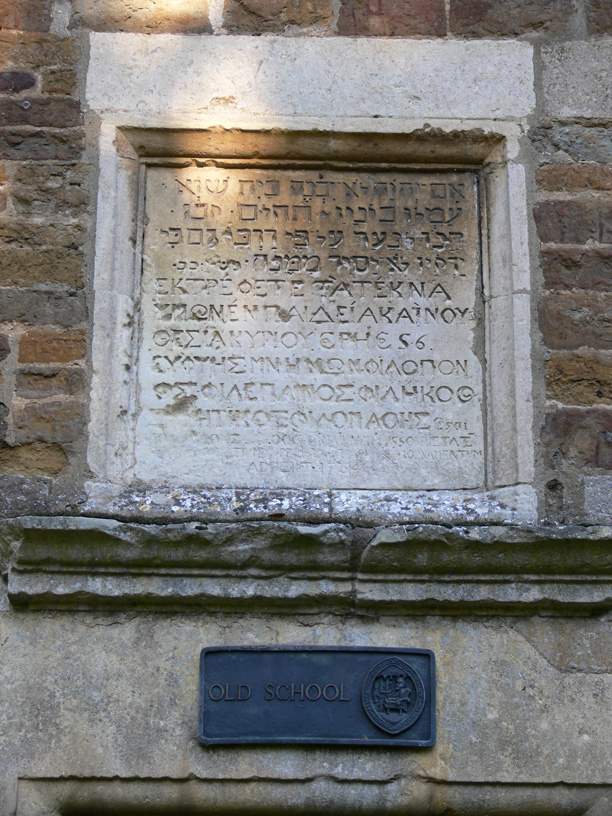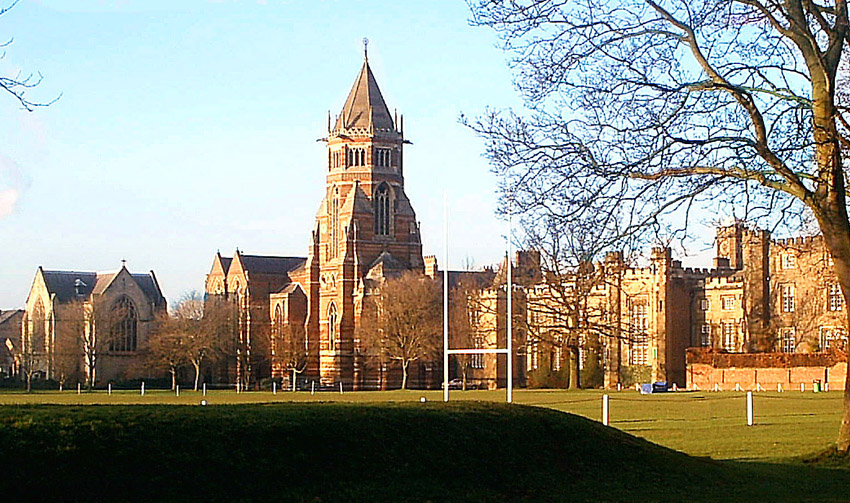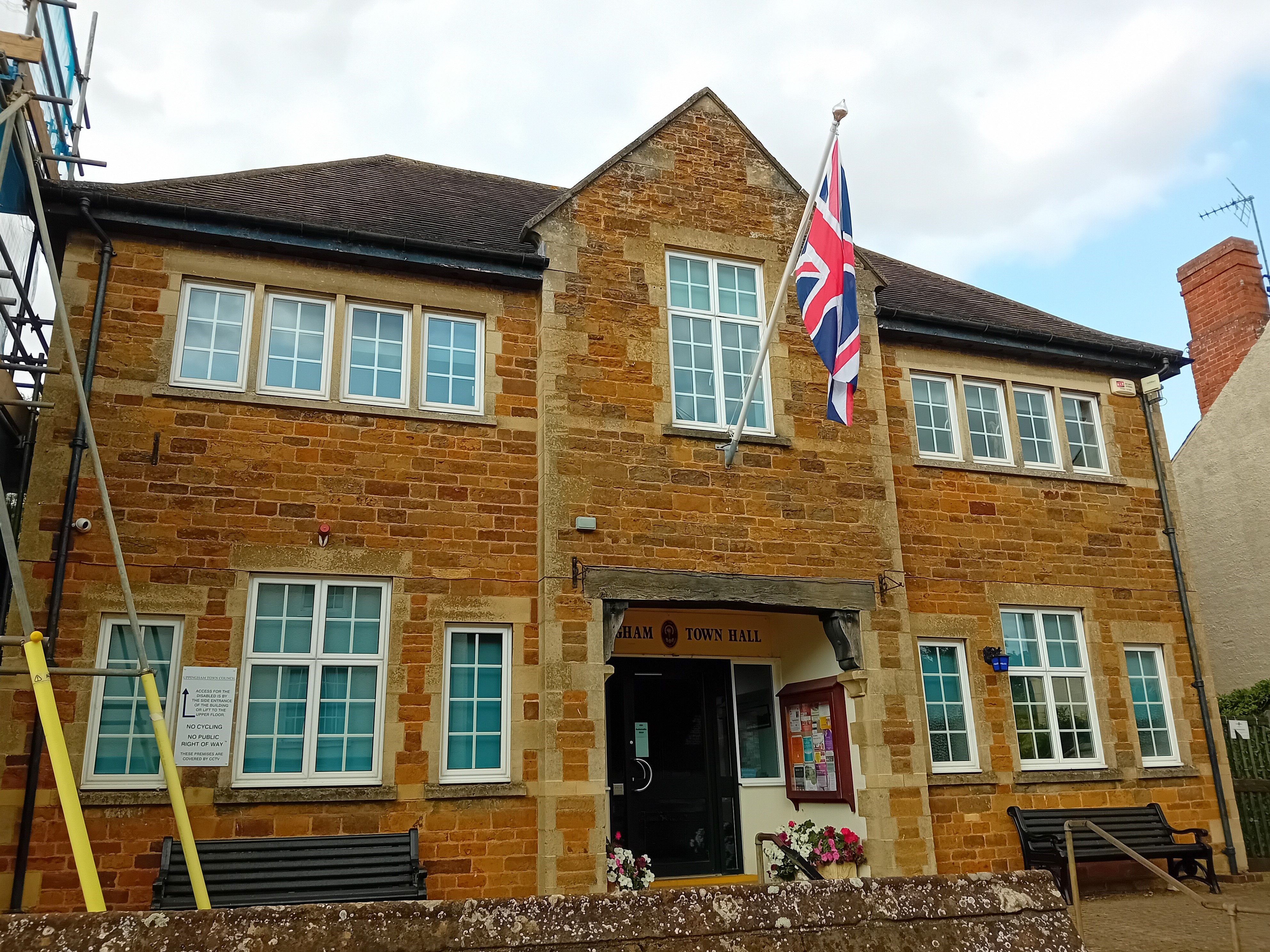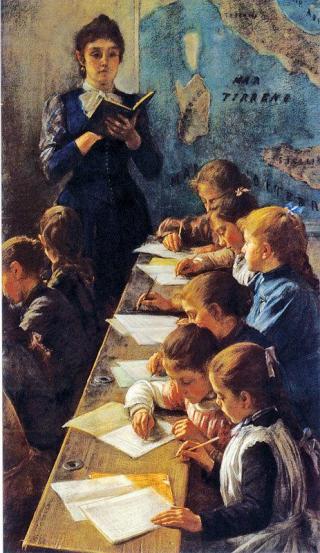|
Oakham School
Oakham School is a public school (English fee-charging boarding and day school) in Oakham, Rutland, England. The school was founded in 1584 by Archdeacon Robert Johnson, along with Uppingham School, a few miles away. They share a common badge design (and a strong rivalry), but while Uppingham's colours tend towards blue and white, Oakham's are black and red. Under headmaster John Buchanan, in 1971 Oakham was the first boys' independent secondary school in Britain to accept both male and female pupils throughout the whole school and not just in the sixth form. In 1995, it was the first public school to go on-line. History Oakham School was founded in 1584 by Robert Johnson, Archdeacon of Leicester. Johnson received an income from four church positions and used this wealth to set up a number of charitable institutions, including the two free grammar schools at Oakham and Uppingham. As someone on the Puritan wing of the Church of England he had a strong belief in the bene ... [...More Info...] [...Related Items...] OR: [Wikipedia] [Google] [Baidu] |
Public School (United Kingdom)
A public school in England and Wales is a type of fee-charging Private schools in the United Kingdom, private school originally for older boys. The schools are "public" from a historical schooling context in the sense of being open to pupils irrespective of locality, Christian denomination, denomination or paternal trade guild, trade or profession or family affiliation with governing or military service, and also not being run for the profit of a private owner. Although the term "public school" has been in use since at least the 18th century, its usage was formalised by the Public Schools Act 1868 (31 & 32 Vict. c. 118), which put into law most recommendations of the 1864 Clarendon Report. Nine prestigious schools were investigated by Clarendon (including two day schools, Merchant Taylors' School, Northwood, Merchant Taylors' and St Paul's School, London, St Paul's) and seven subsequently reformed by the Act: Eton College, Eton, Shrewsbury School, Shrewsbury, Harrow School, Ha ... [...More Info...] [...Related Items...] OR: [Wikipedia] [Google] [Baidu] |
Uppingham
Uppingham is a market town and civil parish in the ceremonial county of Rutland, England, off the A47 between Leicester and Peterborough, south of Oakham. It had a population of 4,745 according to the 2011 census, estimated at 4,853 in 2019. The town is known for its eponymous public school. With its art galleries Uppingham has become a popular destination for art lovers. Uppingham was named "best place to live in the Midlands in 2022" by ''The Times'' newspaper, who commented on the town by calling it "a discerning market town with art, heart and smarts — plus the magnificent Rutland Water". Toponymy The name of the town means 'Homestead/village of the Yppingas (upland people)'. It stands on a high ridge near Beaumont Chase, hence "upland". History A little over to the north-west at Castle Hill are the earthwork remains of a medieval motte and bailey castle. Uppingham became a market town in 1281 when the lord of the manor was given the right to hold a weekly marke ... [...More Info...] [...Related Items...] OR: [Wikipedia] [Google] [Baidu] |
Lancing College
Lancing College is a Public school (United Kingdom), public school (English Private schools in the United Kingdom, private boarding school, boarding and day school) for pupils aged 13–18 in southern England, UK. The school is located in West Sussex, east of Worthing near the village of Lancing, West Sussex, Lancing, on the south coast of England. Lancing was founded in 1848 by Nathaniel Woodard and educates c. 600 pupils between the ages of 13 and 18; the co-educational ratio is c. 60:40 boys to girls. Girls were admitted beginning in 1971. The first co-ed, Saints’ House, was established in September 2018, bringing the total number of Houses to 10. There are 5 male houses (Gibbs, School, Teme, Heads, Seconds) and 4 female houses (Fields, Sankeys, Manor, Handford). Overview The college is situated on a hill which is part of the South Downs, and the campus dominates the local landscape. The college overlooks the River Adur, and the Ladywell Stream, a holy well or sacred strea ... [...More Info...] [...Related Items...] OR: [Wikipedia] [Google] [Baidu] |
Dictation (exercise)
Dictation is the transcription of spoken text: one person who is "dictating" speaks and another who is "taking dictation" writes down the words as they are spoken. Among speakers of several languages, dictation is used as a test of language skill, similar to spelling bees in the English-speaking world. Secondary to teaching language skills, the exercise of dictation has also been used to introduce students to literary works, and to instill morals. Dictation has also been used in an attempt to capture endangered or dying languages, as in the case of Victoria Howard, a Chinook Jargon, Chinook speaker who dictated songs and stories to Melville Jacobs. Etymology It derives from Latin, ''dictāre'' (to assert). Method The exercise requires at least two persons: a reciter and a recorder. The reciter reads a selected text, evenly and clearly and at audible volume, by snippets of multiple words (three to ten or as need be). The text is transcribed by the recorders, as the reciter proce ... [...More Info...] [...Related Items...] OR: [Wikipedia] [Google] [Baidu] |
Arithmetic
Arithmetic is an elementary branch of mathematics that deals with numerical operations like addition, subtraction, multiplication, and division. In a wider sense, it also includes exponentiation, extraction of roots, and taking logarithms. Arithmetic systems can be distinguished based on the type of numbers they operate on. Integer arithmetic is about calculations with positive and negative integers. Rational number arithmetic involves operations on fractions of integers. Real number arithmetic is about calculations with real numbers, which include both rational and irrational numbers. Another distinction is based on the numeral system employed to perform calculations. Decimal arithmetic is the most common. It uses the basic numerals from 0 to 9 and their combinations to express numbers. Binary arithmetic, by contrast, is used by most computers and represents numbers as combinations of the basic numerals 0 and 1. Computer arithmetic deals with the specificities of the ... [...More Info...] [...Related Items...] OR: [Wikipedia] [Google] [Baidu] |
Modern Languages
A modern language is any human language that is currently in use as a native language. The term is used in language education to distinguish between languages which are used for day-to-day communication (such as French and German) and dead classical languages such as Latin and Classical Chinese, which are studied for their cultural and linguistic value. SIL Ethnologue defines a living language as "one that has at least one speaker for whom it is their first language" (see also Language § Linguistic diversity). Teaching Modern languages are taught extensively around the world; see second language acquisition. English is taught as a second or foreign language in many countries; see English language learning and teaching. Auxiliary languages International auxiliary languages are by definition not associated with a particular country or geographic region. Esperanto is probably the best-known and most widespread. Interlingua, a much less popular, but still growing auxili ... [...More Info...] [...Related Items...] OR: [Wikipedia] [Google] [Baidu] |
Science
Science is a systematic discipline that builds and organises knowledge in the form of testable hypotheses and predictions about the universe. Modern science is typically divided into twoor threemajor branches: the natural sciences, which study the physical world, and the social sciences, which study individuals and societies. While referred to as the formal sciences, the study of logic, mathematics, and theoretical computer science are typically regarded as separate because they rely on deductive reasoning instead of the scientific method as their main methodology. Meanwhile, applied sciences are disciplines that use scientific knowledge for practical purposes, such as engineering and medicine. The history of science spans the majority of the historical record, with the earliest identifiable predecessors to modern science dating to the Bronze Age in Ancient Egypt, Egypt and Mesopotamia (). Their contributions to mathematics, astronomy, and medicine entered and shaped the Gree ... [...More Info...] [...Related Items...] OR: [Wikipedia] [Google] [Baidu] |
All Saints' Church, Oakham
All Saints' Church, Oakham is a parish church in the Church of England in Oakham, Rutland. It is Grade I listed. History The spire of Oakham parish church dominates distant views of the town for several miles in all directions. The impressive west tower and spire, built during the 14th century in the Decorated Period, Decorated Gothic style, are slightly earlier in date than most of the rest of the exterior of the building, which (apart from some Victorian restoration) is in the Perpendicular Period, Perpendicular style. Oddly, the south doorway and its porch seem to be the oldest parts of the church, the doorway probably dating from the early 13th century with the porch having been added later that century. In the light, spacious interior there is more evidence of the mature Decorated style of the 14th century. The tall, slender columns of the nave have intricately carved capital (architecture), capitals showing animals, birds, figures, foliage and scenes from the Bible in ... [...More Info...] [...Related Items...] OR: [Wikipedia] [Google] [Baidu] |
Endowed Schools Act 1869
The Endowed Schools Act 1869 ( 32 & 33 Vict. c. 56) was an act of the Parliament of the United Kingdom. It was one of the Endowed Schools Acts 1869 to 1948. It was passed during William Ewart Gladstone’s first ministry, to restructure endowed grammar schools in England and Wales (one jurisdiction). Firstly the Clarendon Commission investigated nine leading schools which led to the Public Schools Act 1868 which restructured the trusts of seven of them. Then the Schools Enquiry Commission (the 'Taunton Commission') was appointed to examine the remaining 782 endowed grammar schools. The commission reported that the distribution of schools did not match the current population, and that provision varied greatly in quality, with provision for girls being particularly limited. The commission proposed the creation of a national system of secondary education by restructuring the endowments of these schools for modern purposes. The Endowed Schools Act 1869 created the Endowed Schoo ... [...More Info...] [...Related Items...] OR: [Wikipedia] [Google] [Baidu] |
Headmasters' Conference
The Headmasters' and Headmistresses' Conference (HMC), formerly known as the Headmasters' Conference and now branded HMC (The Heads' Conference), is an association of the head teachers of 351 private fee-charging schools (both boarding schools and day schools), some traditionally described as public schools. 302 members are based in the United Kingdom, Crown dependencies and Ireland. There are 49 international members (mostly from the Commonwealth) and also 28 associate or affiliate members who are head teachers of state schools or other influential individuals in the world of education, who endorse and support the work of HMC. History The Conference dates from 1869 when Edward Thring, Headmaster of Uppingham School, asked sixty of his fellow headmastersLeinster-Mackay, Donald P. ''The educational world of Edward Thring: a centenary study'', Falmer Press, 1987, , . p. 100 to meet at his house to consider the formation of a "School Society and Annual Conference". Fourteen accept ... [...More Info...] [...Related Items...] OR: [Wikipedia] [Google] [Baidu] |
Queen Elizabeth I
Elizabeth I (7 September 153324 March 1603) was Queen of England and Ireland from 17 November 1558 until her death in 1603. She was the last and longest reigning monarch of the House of Tudor. Her eventful reign, and its effect on history and culture, gave name to the Elizabethan era. Elizabeth was the only surviving child of Henry VIII and his second wife, Anne Boleyn. When Elizabeth was two years old, her parents' marriage was annulled, her mother was executed, and Elizabeth was declared illegitimate. Henry restored her to the line of succession when she was 10. After Henry's death in 1547, Elizabeth's younger half-brother Edward VI ruled until his own death in 1553, bequeathing the crown to a Protestant cousin, Lady Jane Grey, and ignoring the claims of his two half-sisters, Mary and Elizabeth, despite statutes to the contrary. Edward's will was quickly set aside and the Catholic Mary became queen, deposing Jane. During Mary's reign, Elizabeth was imprisoned for nea ... [...More Info...] [...Related Items...] OR: [Wikipedia] [Google] [Baidu] |
Royal Charter
A royal charter is a formal grant issued by a monarch under royal prerogative as letters patent. Historically, they have been used to promulgate public laws, the most famous example being the English Magna Carta (great charter) of 1215, but since the 14th century have only been used in place of private acts to grant a right or power to an individual or a body corporate. They were, and are still, used to establish significant organisations such as boroughs (with municipal charters), university, universities, and learned society, learned societies. Charters should be distinguished from royal warrant of appointment, royal warrants of appointment, grant of arms, grants of arms, and other forms of letters patent, such as those granting an organisation the right to use the word "royal" in their name or granting city status in the United Kingdom, city status, which do not have legislative effect. The British monarchy list of organisations in the United Kingdom with a royal charter, ... [...More Info...] [...Related Items...] OR: [Wikipedia] [Google] [Baidu] |







